#gare d’austerlitz
Text

31 notes
·
View notes
Text
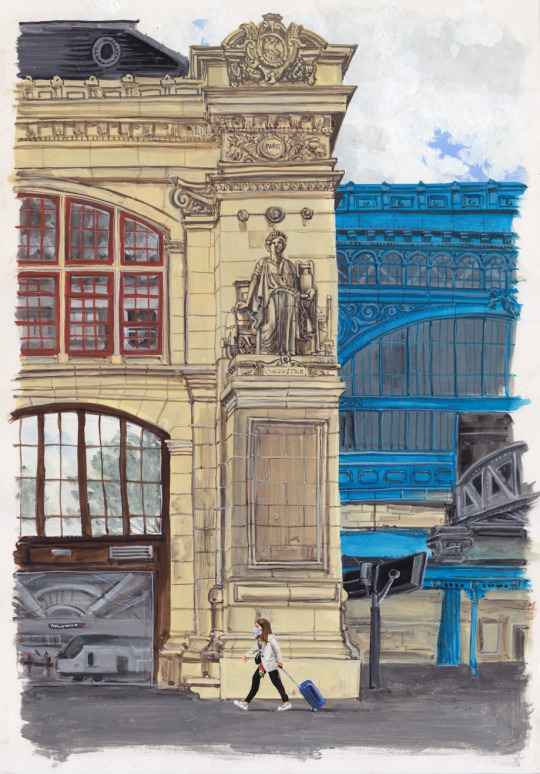
Cour du Départ, gare d’Austerlitz (Paris 13e) – gouache format A3, mai 2021.
VISIBLE dans l’exposition VILLE, MER, CAMPAGNE, jusqu’au 18 novembre, galerie Arts Factory, 27, rue de Charonne, 75011 Paris, tous les jours sauf le dimanche de 12h30 à 19h30.
#2021#cour du depart#gare d'austerlitz#gare#paris#13e#passante#masque#valise#sculpture#industrie#gouache#paysage#paysage gouache#paysage gouache a3#station metro#fer#sncf#station#marche
37 notes
·
View notes
Text
bonjour bonsoir bienvenue dans une fois de plus un post sur 300 000 km/s décrété meilleure découverte cinématographique de l’année par le jury composé de moi (et @pigeonneaux aussi, je pense) aujourd’hui je vais aller beaucoup trop dans les détails et sur-analyser chaque moment because i’m an annoying fucker like that
- détails en tout genre
- d’abord l’invitation de lucien à la convention des inventeurs à genève est pour le 23 avril 1956, on peut donc supposer, étant donné que lucien se casse avec sa valise le soir, que le train part le lendemain matin très tôt ou très tard le soir, donc que l’intrigue se déroule le 22 avril 1956
- son billet de train indique paris est (avec une étape à lyon). on pourrait penser qu’il va aller gare de l’est, mais NON mes croquants, parce que la gare de l’est ne dessert pas lyon. il pourrait aller gare d’austerlitz, mais il est quand même vachement plus probable qu’il soit allé gare de lyon, pour descendre à lyon-perrache ou lyon-brotteaux (aujourd’hui lyon-part-dieu).
- d’ailleurs, après moult recherches et calculs compliqués, j’ai conclu que lucien habitait dans le 12ème, vu qu’il avait l’air bien parti pour rejoindre la gare à pied, je dirais qu’il habite dans le quartier de picpus, et je décrète que son appart est rue bignon, just because i can
now let me tell you a funny story. ces putains de vues de la fenêtre de lucien sont extrêmement chiantes. parce que vraiment je suis allé vérifier sur plein de sites la géographie de paris, je croise les infos mentionnées ci-dessus, et par tous les dieux lucien habite forcément dans le douzième ou le treizième arrondissement. sauf que non. tout ce que je viens de dire sur le billet de train mis à part ce qui est écrit dessus (départ paris est pour genève avec une étape à lyon), là où il habite : j’ai dit de la merde. avec @thehermitsacedia (feat nos énormes cerveaux) on s’est pris la tête pendant une demi-heure à chercher comment joindre les gares et l’appart. nous en sommes arrivés à la conclusion suivante : d’après la fenêtre lucien habite indubitablement à montmartre, serait descendu à pied pour prendre le métro à la motte-picquet pour joindre gare d’austerlitz. techniquement vous n’avez pas besoin de savoir tout ça mais ça nous a coûté des larmes du sang et de la frustration alors je vous oblige à connaître ces informations.

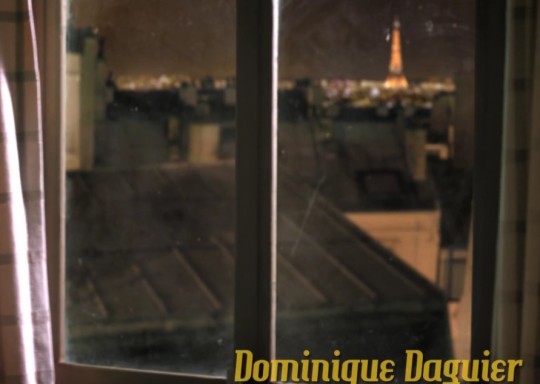
- j’ajoute qu’il voyage en seconde classe, c’est donc vraiment le gars lambda qui a assez de thune pour pas voyager en troisième mais qui ne peut pas se permettre de voyager en première (ou choisit de ne pas le faire pour éviter de se faire remarquer).
- le symbole de l’Organisation :

(thank god i managed to have a clear shot)
alors j’y connais pas grand chose en symboles, m’enfin de ce que je vois :
- le cercle = à peu près tout ce que vous voulez, de dieu au soleil, le cercle a une histoire symbolique aussi longue que vos deux bras
- le triangle avec un cercle rempli dedans = ça ressemble vachement à l’oeil de la connaissance, ce qui serait pas illogique vu que la justification de bauchamp pour voler les inventions des autres c’est la connaissance, je pense que c’est une ligne directrice de l’Organisation. ce symbole, on le retrouve sur les billets de banque américains, mais dans beaucoup d’autres endroits, et si on veut aller dans le complotisme, l’Organisation se présente comme puissante, présente dans le monde entier, beaucoup de scientifiques parmi ses membres = illuminati (aller hop, ça c’est fait...), quand on s’intéresse deux secondes à la véritable histoire des illuminatis, ça peut faire sens
- la ligne en bas = je sais pas, moi de ce que j’interprète de ce symbole dans l’ensemble ce serait ligne = Terre, oeil = Organisation, les deux lignes qui partent en haut = une sorte de faisceau qui élève la connaissance/l’Organisation au-dessus de tout.
ces analyses sont sponsorisées par mon amour indécent pour les romans de dan brown
- ils injectent à lucien un sérum de vérité. j’allais faire un point comme quoi c’est pas possible mais on est dans un monde où un mec a réussi à inventer une montre à voyager dans le temps. alors bon. pour une fois dans ma vie je vais fermer ma gueule.
- le père de lucien cherchait à démontrer que le temps n’est pas une chose linéaire. je vais pas m’épendre en explications mais déjà avant de parler de ça il faut se rentrer dans le crâne que le temps est un concept. sa linéarité est une illusion. le temps est quelque chose perpétuellement en mouvement qui n’est même pas démontrable d’un point de vue chimique (y’a pas de particules de temps. c’est un concept.). et je vous parle même pas de la théorie des cordes (= le multivers). pour plus d’informations allez regarder l’exoconférence de monsieur astier vous apprendrez deux trois trucs
- contrairement à ce qu’on pourrait croire, si lucien avait bien révisé, il devait en connaître un rayon sur la physique quantique. lucien lacroix connaît l’électrodynamique quantique (si si.)
- passons maintenant à lucien
- DONC. lucien est né le 5 juillet 1916 (merci bauchamp pour toutes ces infos). au moment de l’intrigue il a donc 40 ans tout pile (on ne manquera pas de lui souhaiter un très joyeux quarante-et-un balais trois mois plus tard).
- d’après mes calculs il avait donc 23 ans au début de la guerre et 28 ans quand elle s’est terminée. la question se pose donc : lucien était-il engagé dans l’armée ? eh bien la réponse est non. laissez-moi vous expliquer. logiquement, après avoir obtenu son bac à 18 ans, il fonce à polytechnique, il ressort de là quatre ans plus tard diplôme en poche, il a donc 22 ans en 1938. la guerre commence un an plus tard, mais lucien est déjà reparti la mèche au vent pour aller étudier à l’institut de physiques de lyon (on va dire qu’il y fait sa license et son master), il sort donc cinq ans plus tard avec en plus son titre de professeur sur son CV, il a donc 27 ans quand il termine ses études, 28 ans à la fin de la guerre en 1945. à moins qu’il ait eu un élan soudain de patriotisme, il ne s’est pas engagé sur la dernière année de la seconde guerre mondiale.
- il a passé son enfance dans le loiret. voilà c’est tout c’est juste un truc que je voulais relever, c’est pas un parisien pur souche
- il est dit qu’il est le fils (manifestement unique) de marguerite jordet (peut-être toujours en vie) et de charles lacroix (lui par contre il est définitivement cané, il bouffe les pissenlits par la racine depuis un certain temps).
- PARLONS DE SON CHER PAPA. tant de choses à dire. bauchamp (thank you again, king) dit que potit lucien a beaucoup souffert des absences répétées de lacroix senior. ce gosse a grandi presque sans voir son père. mais au lieu de le détester ou d’être indifférent, lucien va reprendre ses travaux sur le voyage temporel, la physique quantique, polytechnique l’institut de physiques tout ça c’est pas du hasard. continuer les travaux de son père c’est la seule manière que lucien a trouvé pour se rapprocher de lui, même après sa mort. il refuse catégoriquement de donner sa machine et est prêt à mourir pour ça parce que sinon ce serait trahir la mémoire de son père. et quand on y pense. est-ce que vouloir construire une machine qui permet de remonter dans le temps ce serait pas essayer de rattraper le temps perdu, ce temps qu’il n’a pas pu passer avec son père ? vous ne me croyez pas ? observez plutôt :
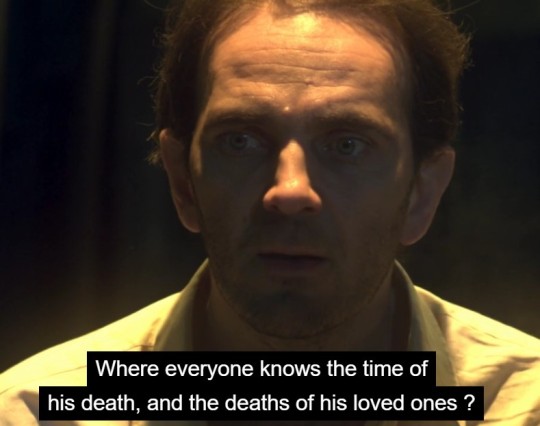
ça c’est la tête du mec qui aurait aimé savoir la date de la mort de son père pour pouvoir passer un max de temps avec lui. “mon invention permettrait d’éviter l’inévitable” oh you mean like the death of your beloved father ? éviter de ne pas avoir connu ton daron parce que t’avais 14 ans et aucune idée que ton père allait mourir si tôt dans ta vie ? is that what you mean lucien ?
putain même la combinaison de son coffre-fort qui contient toutes ses notes, des années de travail, devinez c’est quoi la combinaison ? la date de la mort de son père. charles lacroix est au centre de tout c’est une évidence
- now on va parler du TUR-FU
- vous pensiez que ce post était terminé. naïf of you to think i will ever shut up. donc alors déjà pour ceux qui l’aurait loupé lucien a voyagé jusqu’au 17 septembre 2037 (il a pris large).
- la chaise et la corde qui retenait lucien ont vieillit mais pas lui. déjà là y’aurait quelques paradoxes/problématiques à soulever (est-ce qu’un objet peut voyager dans le temps sans vieillir ? pourquoi l’homme n’est pas affecté ? lucien est-il partit sur un autre plan physique pour voyager, mais pas les objets ? je suis une tanche en physique par contre ça ça me passionne)
- ah, le futur... eh bah apparemment c’est bien de la merde : tout le monde porte des masques (covid/pollution quand tu nous tiens...), manifestement y’a beaucoup de gens à la rue (mais genre plus qu’aujourd’hui), une sécurité/surveillance accrue (l’hélico qui passe), l’Organisation doit avoir des mecs partout, et avec l’avènement d’internet (dont ils ont pu sûrement avoir le contrôle très rapidement, tentaculaire organisation qu’elle a l’air d’être), tout ce bordel doit rappeler 1984 de george orwell au spectateur et sûrement le fascisme pour lucien.
- en parlant d’avoir des mecs partout, je soupçonne que l’Organisation a placé cet homme de main près de l’entrepôt parce qu’ils avaient compris qu’ils finiraient par tomber sur lucien, peut importe l’époque. ça expliquerait pourquoi le garde l’a apparemment tout de suite reconnu.
voilà j’espère que vous avez bien tout lu parce que j’ai sacrifié trois heures pour écrire et faire mes recherches. la bise et à dans un futur proche pour sûrement encore beaucoup de posts sur mon p’tit coeur préféré, lucien lacroix voyageur temporel inexpérimenté
#la complainte de julot#post beaucoup trop long avouons-le#mais c'était fun#for the most part#300 000 km/s#lucien lacroix
4 notes
·
View notes
Text
Final Exam Reflection
1. We took the metro line 5 to Boulevard Voltaire in the 11th arrondissement which was an interesting site to visit as it was very close to Place de la Republique which we visited a few days prior. This boulevard begins at Place de la Republique and ends at Place de la Nation, spanning 2,850 meters (1). There are many streets that intersect with it, making it a major roadway in the city that houses a variety of shops and restaurants. We walked down this boulevard while going to the next metro station starting at Place de la Republique and used it as an opportunity to look at the shops and the people that walked along the sidewalks.

2. In the 6th arrondissement, we searched for the sundial. We followed directions based on the location given on our worksheet, putting it into google maps and also our RATP app. When we were walking, I was looking around enjoying the scenery, and I noticed some interesting art on the buildings. Eventually, our directions told us we had passed the sundial’s location. Confused, I looked up a picture of the sundial online so I knew what exactly we were looking for since I wasn’t even sure what a sundial looked like. When the pictures came up, I realized I had already seen it on the buildings we passed and thought it was just some weird-looking art. We backtracked and were able to find it on the corner of a building next to a restaurant. Upon further research, we found out that Paris has 120 sundials, and Salvador Dalí designed this particular sundial as a present to his friends who owned a boutique at the address number 27 rue Saint-Jacques (French Moments).

3. After taking metro 5 to the Jardin de Plantes was very easy to find in the 5th Arrondissement, as it was just 900 feet from the Gare d’Austerlitz station. Inside, the Garden was very large and all the sites seemed spaced out. Overall, the Jardin de Plantes contained 11 gardens, 6 main places to visit within, and even adorable cafe stands scattered throughout. From additional research, we learned the garden's main attractions include its beautiful gardens (of course), library, exhibitions, gallery, and zoo that was founded largely due to the animals brought from the Palace of Versailles (2). Since we were instructed to find the zoo specifically, we found a map near the front gates and discovered “Menagerie” which refers to the collection of wild animals, and followed the signs posted from there to locate the zoo’s entrance. While the garden itself is free, it does cost 10-13 euros to see the zoo animals. Inside, the Jardin de Plantes Zoo houses around 150 different species of animals, including some of our favorites: kangaroos, flamingos, and snow leopards (2)
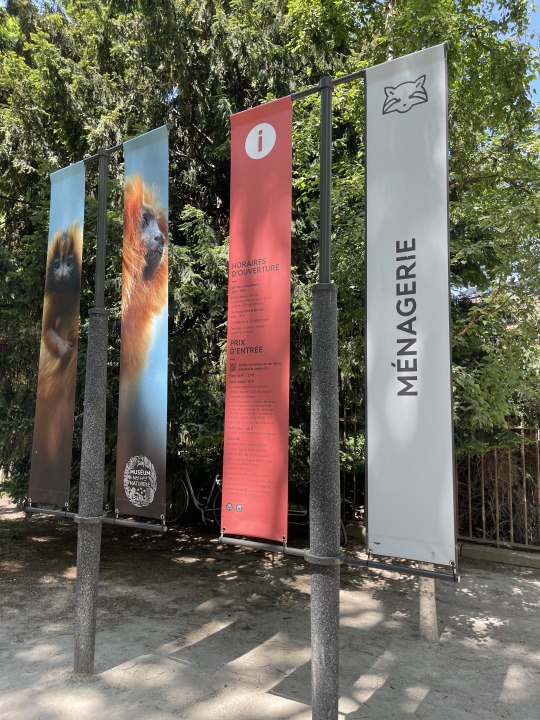
4. From Boulevard Voltaire, we took metro line 4 to Saint Sulpice church as we searched for Rimbaud’s “Le Bateau Ivre”. We walked through a square in front of the church to a side street with a large wall that the poem was written. This poem spans 300 meters across a wall written in large lettering with the author’s name being displayed twice near the end of the poem (2). The poem is one-hundred lines long and tells the story of a sinking boat and reflects the struggles of Rimbaud himself in his career as a poet. This poem is considered to be his greatest work and has been memorialized on the wall on 4 rue Ferou.
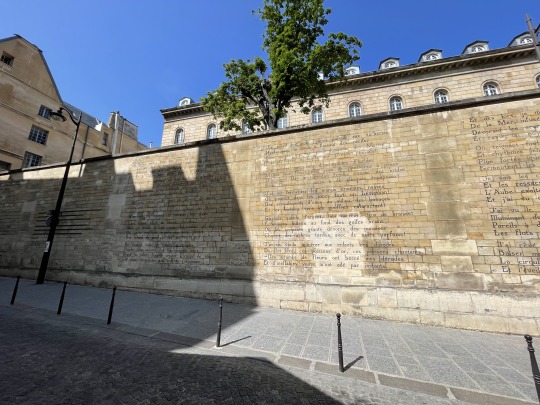
5. During our travels in between locations, we passed through the Place de République, which houses a large monument at the center. At the top of the monument is a statue of Marianne, wearing the Phrygian cap and holding an olive branch. The Phrygian cap is a symbol of freedom, and the olive branch is a symbol of peace. Her second hand is resting on a tablet, and the tablet says “human rights”. This monument was erected in 1883 and represented freedom and the history of people fighting for freedom and rights in the French Republic. We found it really awesome that the symbol of Marianne is so meaningful to the French people that a statue of her this large was erected.

6. Montparnasse Cemetery, located in the 6th Arrondissement was very lovely to visit. As we entered its main gates, we first noticed how wide and straight streets were. This was rather eye-catching to us since the dirt roads were very different from the cobblestones in the Père Lachaise Cemetery. Nevertheless, we found the grace of Jean-Paul Sartre and Simone de Beauvoir just right of the cemetery’s main entrance. The grave itself was designed in a very typical fashion: a rectangular base and a headboard piece with the names and lifespan of the deceased listed, however, it was covered in many unusual markings. All across the back headpiece, as well as along the base, pink and red colored kids' marks, hearts, and other love-related designs were drawn with what appeared to be crayons or lipstick. After researching the reasoning behind the markings we learned that Jean-Paul Sartre and Simone de Beauvoir were the first pair of known models of an open relationship. The pair never owned a home together but would instead meet daily at cafes to converse, gossip about their other partners, and edit each other's work (6). Supposedly, the two were both writers and never published a piece without the other’s input. While there are many more dramatic details to read further into the lives of Jean-Paul Sartre and Simone de Beauvoir, their legacy left behind is ionic for its pushback against social norms, as well as the questions it raises regarding what love looks like.

7. We walked from Parc des Buttes Chaumont to the top of Passerelle Bichat, the pedestrian bridge that crosses Canal St. Martin. This bridge was very unique to walk across in that it was not shaped or structured like a typical bridge. It was much higher than expected and seemingly came to a point at the top of the steep stairs. The Canal St. Martin that it crosses over was created in the 1820s and was intended to provide clean drinking water to the city (3). There is a park on one side of the bridge with an area for children to play and it seems to be located in a more residential area of the city.
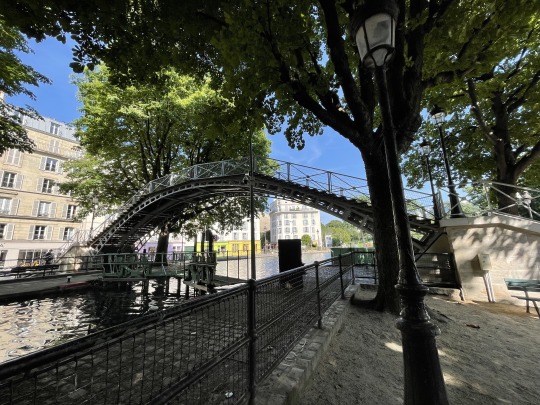
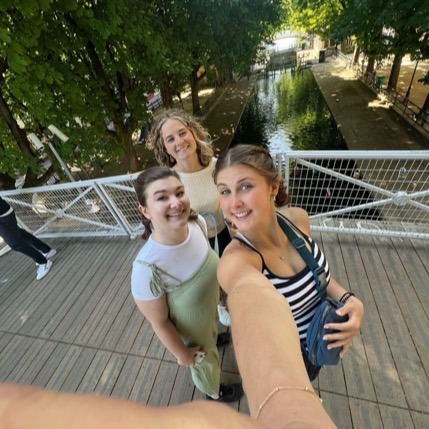
8. The first place that we went was to the Temple of the Sibyl in 19e. The temple is in the Parc des Buttes Chaumont, which is a beautiful green area with trails for walking, a large green hill for hiking or sitting for a picnic, an island with the temple, and a waterfall. The temple sat at the highest point of the island. Unfortunately, when we went to the bridges to get on the island, the island was blocked off and we were unable to enter and get on the island to get a closer look at the temple. The temple looked to have a Romanesque design to it and was inspired by the Temple of Vesta in Tivoli, Italy (Ackteon, Paris – Buttes Chaumont – Le temple de la Sybille, Flickr).

9. This Maille brand mustard was found in a Franprix grocery store located on Avenue de Laumiere. While the grocery store as a whole was dairy small in size, it seemed to have everything in stock that a Parisian would need to cook a nice meal. Within the store, we found the mustard in one of the aisles that were specific to condiments, similar to the grocery stores in the US. At first glance, we were all surprised by the faint yellow color of the mustard.

References
(1) “Origin and History of Boulevard Voltaire.” n.d. Accessed May 27, 2023. http://www.evous.fr/Origine-et-histoire-du-Boulevard-Voltaire,1161616.html.
(2) “Paris: Le Bateau Ivre Fresco by Arthur Rimbaud, Rue Férou Illuminated by the Words of the Poet - VIème - Paris La Douce, Parisian Magazine Lifestyle, Culture, Outings, Street Art.” n.d. Accessed May 27, 2023. https://www.parisladouce.com/2020/10/fresque-le-bateau-ivre-paris-rue-ferou.html.
(3) Paris, Office du Tourisme et des Congrès de. n.d. “Balade Du Canal Saint-Martin à La Villette Paris - Office de Tourisme Paris.” Accessed May 27, 2023. https://www.parisinfo.com/decouvrir-paris/balades-a-paris/paris-de-belleville-a-la-villette.
(4) Ackteon. (n.d.). Paris – Buttes Chaumont – Le temple de la Sybille. Flickr. https://www.flickr.com/photos/73553452@N00/8748730408
(5) Pierre. (2020, June 13). Where to find the Salvador Dali Sundial in Paris - French Moments. French Moments. https://frenchmoments.eu/salvador-dali-sundial-paris/
(6) “Simone de Beauvoir et Jean-Paul Sartre, Un Couple Mythique de La Littérature.” 2014. Www.Rtl.Fr. January 9, 2014. https://www.rtl.fr/actu/simone-de-beauvoir-et-jean-paul-sartre-un-couple-mythique-de-la-litterature-7768645019.
@haleylongcore @nataliedeal02
0 notes
Text
Ronaldo in Paris, the twist
First announced for 2021, the opening of Cristiano Ronaldo’s hotel in Paris is now scheduled for 2027, in the Gare d’Austerlitz district.
Cristiano Ronaldo in Paris, it will be done well! The fivefold Ballon d’Or hotel will indeed open in the French capital, by 2027. The opening of the CR7 establishment in Paris was announced in 2018 for 2021, but we will therefore have to wait a little longer…

View On WordPress
0 notes
Text

Passion sunset #xx : burning in the miror @ quai d’Austerlitz facing port de la râpée, Gare de Lyon
#sunset#sky is burning#burning sky#sunset in the miror#quai d’austerlitz#paris austerlitz#paris gare de lyon#gare de lyon#paris#seine#river#les quais#building#miroir#shinny
2 notes
·
View notes
Photo

Gare D’Austerlitz Paris
Photo: Dieter Krehbiel
#gare d'austerlitz#high contrast#low key#Black and White#Street Photography#Green Eyes 55#Dieter Krehbiel#black and white photography#urban life#metro station#source:forthepleasureofmylife#urban#billboard#advertising#photographers on tumblr#Waiting#Paris#france#source: forthepleasureofmylife#cool#coolness#metro#subway station#subway#2010s
45 notes
·
View notes
Video
BB 22323 SNCF OSLO / Meung-sur-Loire by Nicolas B.
Via Flickr:
Marche 'Formation' Paris Gare d’Austerlitz - Nantes via Les Aubrais. OSLO : Offre de Services Librement Organisés appartenant à SNCF Voyageurs SA
1 note
·
View note
Text
Trains in Miraculous Ladybug - Part 4: Le Gare du Nord
[Part 1: The Metro Train]
[Part 2: The Metro Station]
[Part 3: Startrain]
Part 4: The Gare Du Nord (you are here)
[Bonus: The Bus]
I’m really happy about the response this series of posts has gotten so far. I honestly didn’t think anyone but me would care; I’m glad to see I was wrong.
This will be the last part, probably, unless they release more trains in Season 4 or I manage to talk myself into doing a bonus round about the bus (the 33 to Gare d’Austerlitz), we’ll see.
So then: Le Gare du Nord, or “North Station”, also sometimes known as “Paris Nord”. It is the Paris station of the “Startrain", just like the real-life Eurostar (we never see the UK one, which would be London St Pancras). This station is one of the big terminal stations in Paris, and is named after the historical company that built it, the Compagnie des chemins de fer du Nord (Company of railways in the north), or in short, the Nord.
As the name implies, both the railway and the station mainly serve destinations north of Paris. That means a lot of commuter trains, but also international trains to the UK via the channel tunnel (like the Eurostar), to Belgium, and via Belgium to the Netherlands and Germany - including to my home town. When I went to Paris, I did it with a train that ran directly there.
While Miraculous Ladybug doesn’t refer to the station by name, the station building they show does have the letters NORD large on it, which is a bit of giveaway.

[Image: Screenshot, showing the top of a building; at one place there are large letters NORD on it]
[Again, I’ll provide image descriptions unless I’m already describing the image in the surrounding text. If you’d prefer something else, please let me know!]
Look at all the details on the station, the statues, the columns. Miraculous Ladybug is generally pretty good with architecture. While their overall degree of detailing is limited, and for example no building is ever dirty there, they always do show more than enough detail to get the message across. There is another great head-on shot in the final episode.

This looks really good. Sadly, I don’t have any good pictures of the station myself. I’d hop in a train and go over and take a new one, but, you know, pandemic.
I was going to say that this is just a joke because of cost and time, but honestly, if I could safely spend next weekend in Paris for, say, 500€, you know I’d totally do it.
Anyway, have a bad picture instead. It’s too close and weirdly angled, but hopefully it illustrates that the show did a good job with the outside.

Actually, now that I compare it, it seems like they left out the statues (which represent cities that you can travel to) and placed the clock too far down. This is something that I only notice now, writing these posts, while I have these pictures next to each other. I think that is something we can let slide, overall.
If you’re interested, you can find better pictures on the Wikipedia page for the station. As you can hopefully see, the station is a very grandiose building, something that truly believed in the 19th century idea of “railway stations as the cathedrals of the modern age”, and Miraculous Ladybug does not shy away from that at all.
The inside is less detailed, but generally mostly okay. Once again, I’m hampered by a lack of photos, this time because I mostly took pictures of trains rather than architecture. I’m not sorry for the train pictures, but they’re not relevant here.
The Gare du Nord is truly built like a modern cathedral with essentially one side missing so that the trains can run in and out. It consists of a main hall, so large that you can easily spot it from most high places in Paris, such as here near Sacré-Cœur de Montmartre:

Not visible are a smaller side halls to the west (left when facing from the front down the tracks) and east (right). Let’s look inside the main hall.

Ignore the white train (or don’t; it’s a repainted old Eurostar train used as a low-cost Paris-Brussels train). The station is built in some ways indeed a lot like a modern update of a classic church: There are three main halls, all steel constructions. This picture is taken in the middle hall, which is the tallest; it is a beautiful cast iron construction. To the left (and right, but that’s not visible on this picture), you have parallel smaller halls. Between the main hall and the smaller halls, you have a set of stone columns each; on top of that are walls with arched windows. That way the middle hall’s roof starts higher than that of the lower halls. Oh, and the whole thing is lit with spherical lamps that are pairwise attached either to lamp posts on the platforms, or to the steel columns that hold up the middle hall’s roof at roughly the third markers of its width.
How does that look in Miraculous Ladybug? Actually really well, as we can see in this screenshot:

There’s the hall, with its roof lights; the steel columns, the arches, the side halls. If we’re counting tracks, it looks like this station is quite a bit smaller than in real life, but that is true for most of Paris’s landmarks in Miraculous Ladybug. For some reason the platform here stops where the hall does; in real life it continues out, which is necessary for the trains that are up to 400 m (~ 440 yards) long.
The Startrain leaves from the west side hall, which again, matches the Eurostar exactly. In the front, we get a train carriage that I can’t quite identify. The shape is distinctly that of a TGV car, but it is too long (at least seven instead of six windows), and the details at the end of the car look wrong.
When we look down the train into the station, we can see some more details.
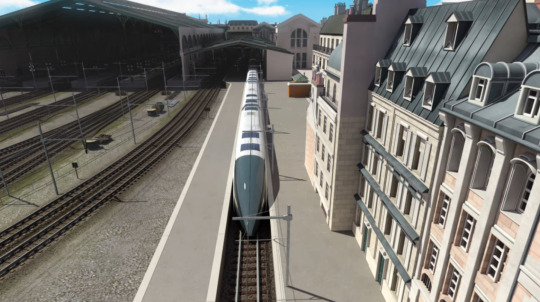
The neighboring buildings here reach right onto the platform, without any separating fence, which is not how that works in real life. The track layout overall looks very simplified and smaller, which is probably acceptable.
Further down the hall, we see that there is not a lot of detail here:

However, they did include the footbridge that is used to access only the Eurostar tracks, a weirdness required because in real life, you need check in like on a plane, and go through a British passport control before you’re allowed to board the train. Thankfully that is not required for the trains to any other countries.
Due to this passport control weirdness, the Eurostar tracks are actually physically separated from the rest of the station with fences in real life. You can see both the footbridge and the fence next to the nose of the white train in that photo above. (I promise, once this pandemic is done I’ll go there, take new pictures, and redo this post)
Weirdly enough, the show does have the fence - but only on the side of the buildings. I do think that fence on that side actually exists, by the way; can’t have people coming into the UK by jumping through a window, after all.

In general, Miraculous Ladybug always omits fences and barriers whenever they can. The observation decks of the Eiffel Tower, for example, have large fences to prevent people from falling down, and there is a large glass barrier all around the base of the tower. All of these things are missing in the show, and it makes sense that they’d keep this approach (more or less) for the trains.
This screenshot also shows another interesting thing: The overhead lines they used here.
If we ignore the Midi lines with the Westinghouse equipment, which we should because they are nowhere near Paris, then France uses two different styles of electrification. One is for the 1500 V DC lines, the older system. Since it has so few Volts it needs more Amperes, which means it needs a lot of cables to transmit it. This is what they’ve portrayed here in the show: You can see that the overhead line equipment has three wires; one that is hanging down and holding the other two, an intermediate wire, and then a lower wire (in real life two wires really close together, you need to get a close look to see this). The lower wire is the one that the pantograph on the locomotive actually touches, in order to complete the electrical circuit (the other side is the locomotive wheels) and get power.
(As explained in Startrain, they didn’t quite get the heights right, so that lowest wire passes through the train. The Startrain doesn’t appear to use the overhead line equipment either way, since it has no pantograph touching the wires at all. Maybe this is a case of France going for gas turbine trains once again.)
They portrayed this really well. There’s just one tiny problem:
The other system in France uses 25 kV AC electricity. This system needs far less copper, so the overhead line only has two wires, the one that appears to be hanging, and one that the locomotive’s pantograph touches.
Guess which version is found in the Gare du Nord.
Yes, that’s right, the show is inaccurate here because the designers did too much work, and used the more complicated type of overhead line where the less complicated would have been correct. I kind of feel sorry for them, but I can’t lie to you guys and pretend it didn’t happen.
There is one final weirdness I want to talk about (and it better be the final, I’m once again at the 10 image limit), which you can see when you’re looking down the length of the train:

The tracks lead out of the station for a little bit, and then merge into one of several tunnels. That is not how the station actually works; instead the lines go straight out, under quite a lot of road bridges.
The “tracks lead directly to tunnel” approach does exist in London King’s Cross station, but that’s really more a rare exception than a usual pattern. If I had to guess, I’d say Miraculous did it that way so they didn’t have to model the bridges; the tunnel is much easier and they can just put houses from their standard collection on top.
Overall, the station is fine. Not perfect, and in my opinion the metro station is better (but also much smaller), but overall good enough. And honestly, they paid way more attention to this than they probably needed to.
It’s easy to criticize the show for its animation errors, its inaccuracies and its over-reliance on asset reuse; hell, this whole post series is to some extent me doing the same. But if you look at the details, it’s also clear that the people making this are spending a lot of time and attention on it, and they really care about how it looks. That deserves a lot of recognition.
[Part 1: The Metro Train]
[Part 2: The Metro Station]
[Part 3: Startrain]
Part 4: The Gare Du Nord (you are here)
[Bonus: The Bus]
26 notes
·
View notes
Photo
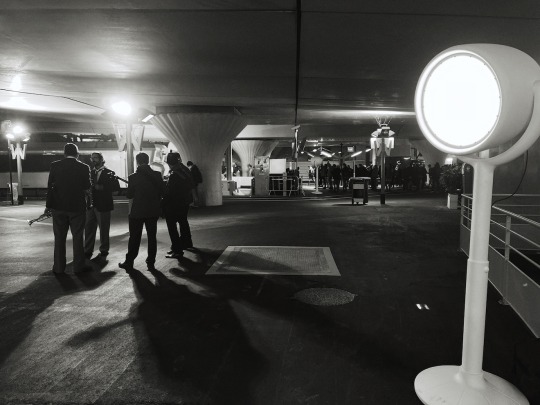
2021 Paris, gare d’Austerlitz.
#2021#Paris#Gare d'Austerlitz#Blackandwhite#Shotoniphone#iPhone#Iphoneography#Photography#Streetphotography#Pierre Wayser
4 notes
·
View notes
Photo

Quand on passe devant la Gare d’Austerlitz et qu’on voit l’avancée des travaux du futur siège
7 notes
·
View notes
Text

#paris#france#streets#people#darkness#light#rer c#gare d’austerlitz#75013#train#station#box#boîte#platform#quai
11 notes
·
View notes
Text
Le dernier train
Echeveau de lunes coulant sur la noirceur du ciel derrière des dunes opalines
Affamé j’échappe aux torpeurs sourdes et lancinantes des tentations Babyloniennes qui cherchent à m’agripper
Yeux fermés je cours vers les soubresauts du salut des âmes égarées
Vers une lumière
Toujours cette faim au ventre
Cette faim qui laboure les entrailles et étrangle l’âme
Ton sexe…
Guirlandes de lampions partout dans les rues reliant les immeubles crasses
Exaltation arachnéenne de lumières bariolées
Flottant dans l’air soudainement tout est beau sous ces lueurs infimes
Je respire
Un instant
Ton profil éclairé à la bougie dans cette minuscule cabane de montagne à deux mille trois-cents mètres
Le vent siffle
Le vent gémit comme toi la nuit
Le froid nous étreint je te serre contre moi tout près du poêle qui crépite
Nous n’aurons pas assez de bois pour la nuit
Mais qu’importe ta chair est dans ma chair et l’on peut vivre mille ans ainsi
Alors voici de nouveau l’affolement des lumières bigarrées stroboscopiques de la Tentation
Et mille lunes encore hurlent la lueur divine écartelée sur le désert noir des impossibles
Toi encore
Nue encore
Toujours encore
Un grain de beauté sur le sein droit
Une cicatrice
Nue toujours
Ta peau blanche et tes tétons roses
Ton plus bel apparat
Fidèle à la perfection de l’aurore salvatrice
Je l’attends
Et toi…
Aussi je t’attends
Sur le quai numéro deux de la gare de Latour de Carol
Le train de nuit en provenance d’Austerlitz
À sept heure vingt-sept chaque année
À chaque tragique anniversaire
Je m’inflige cette mise en scène je veux revivre ce moment
Je rêve qu’il n’ait jamais existé et pourtant c’était si beau
C’est là qu’on s’est vus pour la dernière fois
La dernière fois que j’ai senti ton odeur
Que je t’ai eue dans mes bras
Bras que je trouve aujourd’hui inutiles tant ils étaient destinés à te servir
À te serrer contre moi
J’aimerais me les arracher par petits bouts comme on plume une pâquerette
Je me rappelle qu’un instant tu as hésité
Sur le marchepied
Tu avais les larmes aux yeux toi si sensible
Me quitter juste quelques jours
Tes cheveux noirs de jais dans les yeux
Une dernière étreinte pour sentir tes seins contre moi
Sentir ton cœur contre moi
Te sentir toi tout entière contre moi
Humer notre amour avant le départ du train
Départ pour l’éternité
Peut-être est-ce pour ça que tu ne voulais pas partir
Tu avais peur de ne jamais revenir
Et que moi je ne puisse te rejoindre à moins de faire le grand saut
Je suis dans le jardin ce matin j’étais à la gare
Cela fait maintenant cinq années et je regarde la lune dégouliner derrières les dunes opalines de la pureté
Tel St Antoine j’ai vu le Diable et j’ai su résister aux tentations Babylone la putain ne m’a pas dévoré
J’ai allumé la guirlande de lampions que tu aimais tant mais il y a trop de vent ce soir
Les bougies s’éteignent
Comme toi
Brusquement
Sans crier
Sans un bruit
Je n’ose même plus y penser
Mon sang fond je me délite
Je ne veux revoir que ton sourire et embrasser ton odeur
Tu es partie allée 3 Division IV du cimetière du Montparnasse
Nous l’aimions tant
Quand on venait à Paris
Avant de la quitter et de revenir la saluer
Celle-là t’a engloutie un soir d’octobre
Une chose bête
Les bougies qui s’éteignent
Une fille seule dans la nuit
L’ignorance de la mort
Qui vise comme un borgne
Et arrache les beautés de terre sans réfléchir
Si brusquement
Je cours vers les âmes égarées
Je cherche mon salut dans toute cette horreur
Derrière ton sourire et ton odeur inatteignable
2 notes
·
View notes
Text

Quand on passe devant la Gare d’Austerlitz et qu’on voit l’avancée des travaux du futur siège
3 notes
·
View notes
Text
Brickclub 2.5.2 - 2.5.5
Catching up on the last four chapters. As usual, I have much less to say about the plot-heavy chapters.
Some stray observations:
The routes and street names on the Left Bank--while tracing an extremely eccentric zigzag path--are fully rooted in the actual map of Paris. Once we cross the Seine in 2.5.2, we’re into an entirely made-up neighborhood. The style of Hugo’s descriptions doesn’t change, and the sense of verisimilitude continues--especially as he sets his made-up Petit-Picpus neighborhood in the area that was completely razed to build the Gare de Lyon.
Hat tip to @meta-squash for pointing out that Valjean crosses the bridge in the shadow of a cart. I would almost take this for an entirely non-metaphorical horse and cart, except that Hugo calls it out in the chapter title, “It Is Fortunate That the Pont d’Austerlitz Takes Vehicles.” Institutions built for all of society also shelter social outcasts, and that’s a good thing?
The Pont d’Austerlitz was technically the Pont de Jardin du Roi at this point, as Hugo mentions in “The Year 1817.” Valjean is walking in Napoleon’s steps again--and he does manage to pull off a surprise victory against numerically superior and overconfident forces. But where Napoleon at Austerlitz was feigning weakness into order to provoke an attack, Valjean’s mistakes here are all real, and desperate.
I wish I knew whether to make anything of the Goblet pottery works beyond local color.
Four and eight alert: including Javert, there are four men pursuing Valjean.
Hat tip to @everyonewasabird for pointing out that Hugo’s “picture a letter of the alphabet” aerial map description of the neighborhood ties the Petit-Picpus to both Waterloo and the barricade. The convent itself is going to be a bridge between the barricade and the bagne, but this chapter is prefiguring the escape from the barricade in a lot of ways. Partly, it’s showing us the same tricks--the convict’s bag of tools--that Valjean will later use to rescue Marius: strength, desperate quick thinking, and the ability to look above or below a two-dimensional trap to find an escape. But the “gate that was not a gate” and the ominously barred and shuttered façades in this street also definitely call forward to the shuttered street in “The Dead Are Right and the Living Are Not Wrong.”
Poor Cosette. She’s trying so hard and she’s so scared. I am definitely side-eying Valjean for threatening her with Mme. Thenardier; that was not at all necessary.
3 notes
·
View notes
Photo


Série B204.
15 janvier 2021. Couverture des voies SNCF entre la gare d’Austerlitz et Tolbiac.
1 note
·
View note